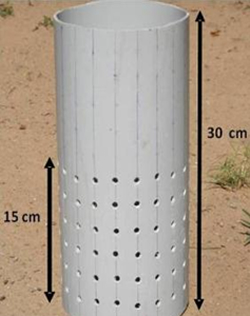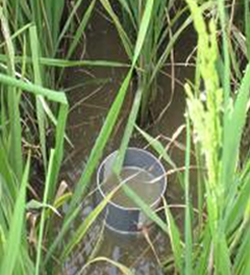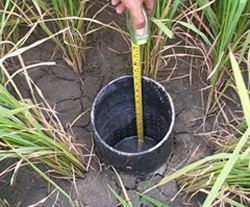Saving Water with Alternate Wetting Drying (AWD)
What is AWD?

Alternate Wetting and Drying (AWD) is a water-saving technology that farmers can apply to reduce their irrigation water consumption in rice fields without decreasing its yield. In AWD, irrigation water is applied a few days after the disappearance of the ponded water. Hence, the field gets alternately flooded and non-flooded. The number of days of non-flooded soil between irrigations can vary from 1 to more than 10 days depending on the number of factors such as soil type, weather, and crop growth stage.
How to implement AWD?
A practical way to implement AWD safely is by using a ‘field water tube’ (‘pani pipe’) to monitor the water depth on the field . After irrigation, the water depth will gradually decrease. When the water level has dropped to about 15 cm below the surface of the soil, irrigation should be applied to re-flood the field to a depth of about 5 cm. From one week before to a week after flowering, the field should be kept flooded, topping up to a depth of 5 cm as needed. After flowering, during grain filling and ripening, the water level can be allowed to drop again to 15 cm below the soil surface before re-irrigation.

AWD can be started a few weeks (1−2 weeks) after transplanting. When many weeds are present, AWD should be postponed for 2−3 weeks to assist suppression of the weeds by the ponded water and improve the efficacy of herbicide. Local fertilizer recommendations as for flooded rice can be used. Apply fertilizer N preferably on the dry soil just before irrigation.
The field water tube (Pani pipe)
The field water tube can be made of 30 cm long plastic pipe or bamboo, and should have a diameter of 10−15 cm so that the water table is easily visible, and it is easy to remove soil inside. Perforate the tube with many holes on all sides, so that water can flow readily in and out of the tube. Hammer the tube into the soil so that 15 cm protrudes above the soil surface. Take care not to penetrate through the bottom of the plow pan. Remove the soil from inside the tube so that the bottom of the tube is visible.

When the field is flooded, check that the water level inside the tube is the same as outside the tube. If it is not the same after a few hours, the holes a probably blocked with compacted soil and the tube needs to be carefully re-installed. The tube should be placed in a readily accessible part of the field close to a bund, so it is easy to monitor the ponded water depth. The location should be representative of the average water depth in the field (i.e. it should not be in a high spot or a low spot).







